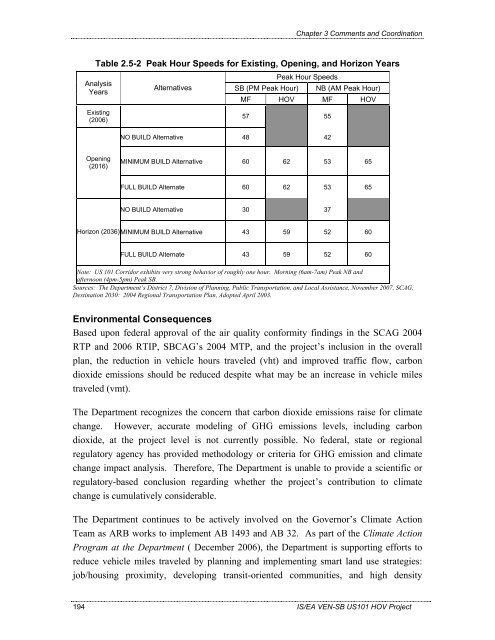Chapter 1 - Caltrans - State of California
Chapter 1 - Caltrans - State of California
Chapter 1 - Caltrans - State of California
Create successful ePaper yourself
Turn your PDF publications into a flip-book with our unique Google optimized e-Paper software.
<strong>Chapter</strong> 3 Comments and Coordination<br />
Table 2.5-2 Peak Hour Speeds for Existing, Opening, and Horizon Years<br />
Analysis<br />
Years<br />
Existing<br />
(2006)<br />
Opening<br />
(2016)<br />
Alternatives<br />
Peak Hour Speeds<br />
SB (PM Peak Hour) NB (AM Peak Hour)<br />
MF HOV MF HOV<br />
57 55<br />
NO BUILD Alternative 48 42<br />
MINIMUM BUILD Alternative 60 62 53 65<br />
FULL BUILD Alternate 60 62 53 65<br />
NO BUILD Alternative 30 37<br />
Horizon (2036) MINIMUM BUILD Alternative 43 59 52 60<br />
FULL BUILD Alternate 43 59 52 60<br />
Note: US 101 Corridor exhibits very strong behavior <strong>of</strong> roughly one hour. Morning (6am-7am) Peak NB and<br />
afternoon (4pm-5pm) Peak SB.<br />
Sources: The Department’s District 7, Division <strong>of</strong> Planning, Public Transportation, and Local Assistance, November 2007, SCAG,<br />
Destination 2030: 2004 Regional Transportation Plan, Adopted April 2003.<br />
Environmental Consequences<br />
Based upon federal approval <strong>of</strong> the air quality conformity findings in the SCAG 2004<br />
RTP and 2006 RTIP, SBCAG’s 2004 MTP, and the project’s inclusion in the overall<br />
plan, the reduction in vehicle hours traveled (vht) and improved traffic flow, carbon<br />
dioxide emissions should be reduced despite what may be an increase in vehicle miles<br />
traveled (vmt).<br />
The Department recognizes the concern that carbon dioxide emissions raise for climate<br />
change. However, accurate modeling <strong>of</strong> GHG emissions levels, including carbon<br />
dioxide, at the project level is not currently possible. No federal, state or regional<br />
regulatory agency has provided methodology or criteria for GHG emission and climate<br />
change impact analysis. Therefore, The Department is unable to provide a scientific or<br />
regulatory-based conclusion regarding whether the project’s contribution to climate<br />
change is cumulatively considerable.<br />
The Department continues to be actively involved on the Governor’s Climate Action<br />
Team as ARB works to implement AB 1493 and AB 32. As part <strong>of</strong> the Climate Action<br />
Program at the Department ( December 2006), the Department is supporting efforts to<br />
reduce vehicle miles traveled by planning and implementing smart land use strategies:<br />
job/housing proximity, developing transit-oriented communities, and high density<br />
194 IS/EA VEN-SB US101 HOV Project

















